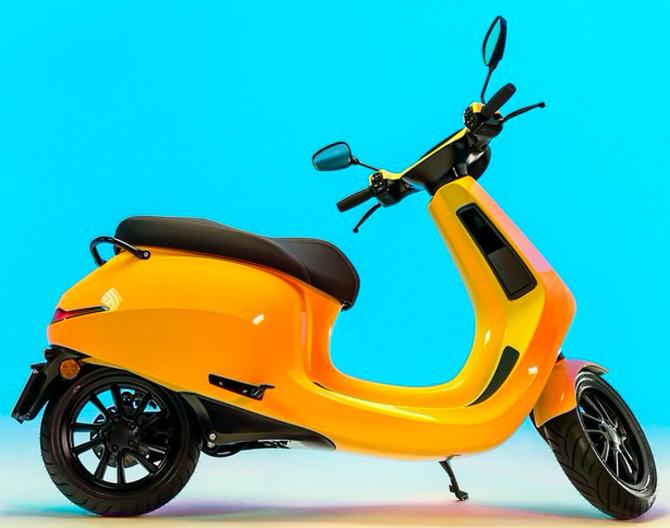For manufacturers of internal combustion engine-powered two-wheelers, such as Bajaj Auto, Hero MotoCorp, and TVS Motor, it will be a double whammy.

The entry of SoftBank-backed Ola into the electric scooter (e-scooter) segment is set to power up the overall market and perhaps fast-track the adoption of battery-operated vehicles.
But for manufacturers of internal combustion engine (ICE)-powered two-wheelers, such as Bajaj Auto, Hero MotoCorp, and TVS Motor, it will be a double whammy.
Not only will they have to contend with the aggressive pricing of Ola’s scooter and incur a loss at each unit of the e-scooter sold, the volumes of their regular (ICE) models, too, could feel the squeeze, observed analysts.
Ola is expected to price its e-scooter in the range of Rs 85,000-1.1 lakh.
The price range is one that accounts for 70 per cent of the conventional ICE scooter sales in the country.
Large listed two-wheeler makers, part of the world’s larges two-wheeler market, are positioning themselves to benefit from the anticipated electric vehicle (EV) adoption, according to a research report by Emkay Global.
“Considering the competition from other original equipment manufacturers (Hero Electric, Ola Electric, Okinawa, Ampere, etc), we expect some pressure on the market share and margins in the medium term,” it said.
India sold a total of 143,837 units of e-two-wheelers in 2020-21, representing penetration levels below 1 per cent.
Emkay expects this could improve to 5-10 per cent over the medium term, with falling EV prices due to the reduction in battery costs, localisation efforts, and scale benefits.
“It’s a double whammy for automakers,” said an analyst at a domestic brokerage, indicating that if Ola indeed prices its models aggressively, others won’t have an option but to match it.
As a result, they will incur a loss on every unit they sell.
“Not to forget, the EV volumes will come at the cost of regular models. Hence, it will be a loss of opportunity as well.”
A day after Ola Electric opened bookings for its yet-to-be-launched e-scooter, Bajaj Auto said the company has opened bookings for the Chetak in Nagpur.
Launched in January 2020, Bajaj has been launching the model in a calibrated way due to supply-related glitches.
Previously, the booking slots available for Pune and Bengaluru were fully subscribed to, in less than 48 hours, and the same is anticipated in Nagpur as well, said Bajaj in a statement.
Rakesh Sharma, executive director, Bajaj Auto, said the company’s ramp-up and booking plans remain unchanged.
They have not been revisited or accelerated because of competition.
“As stated earlier, we plan to have a presence in 25 cities by the end of the fourth quarter,” said Sharma.
Recently, Bhavish Aggarwal-led firm said it has garnered 100,000 bookings in 24 hours.
While it remains to be seen whether the high decibel pitch ahead of the launch translates into sales, it is grabbing eyeballs for now.
"No matter how this scooter ultimately fares, it is exciting to see courage and risk-taking being rewarded.
"The more entrepreneurs that follow the lead of @bhash and show no fear of failure, the more robust Indian innovation will become,” Anand Mahindra, chairman, Mahindra Group, tweeted on Sunday.
For all the excitement around e-two-wheelers, analysts are also unsure of the price viability after the end of subsidy. Last month, making an amendment to the FAME incentive scheme, the government increased the demand incentive for e-two-wheelers to Rs 15,000 per kilowatt hour (kWh), from the earlier uniform subsidy of Rs 10,000 per kWh for all EVs.
It also capped incentives for e-two-wheelers at 40 per cent of the cost of vehicles, up from 20 per cent earlier.
India sells close to 16 million two-wheelers annually. According to Mahantesh Sabarad, head, retail research, SBICAP Securities, while electrification is set to happen at a rapid pace due to the falling cost of ownership of e-two wheelers — fuelled largely by incentives and rising petrol prices — one cannot say whether Ola will be a big beneficiary.
“Ola’s speed and hurry to launch the model makes me unsure of its success.
"There are a lot of unknowns when it comes to its product,” said Sabarad, referring to the product specification and overall preparedness.
Meanwhile, others, too, are gearing up for an EV ride.
TVS Motor has created a separate vertical for EVs and outlined a Rs 1,000-crore investment plan over the next two years, a financial daily reported recently.
The launches are targeted at segments such as premium scooters, high-performance sport motorcycles, commuter space, delivery market, and three-wheelers.
Two-wheeler market leader Hero MotoCorp — that backs Ather Energy — has aggressive plans for the segment.
Photograph: Courtesy Olacabs












 © 2025
© 2025